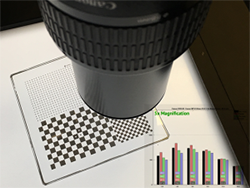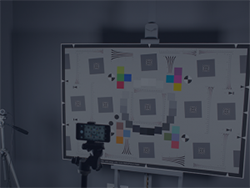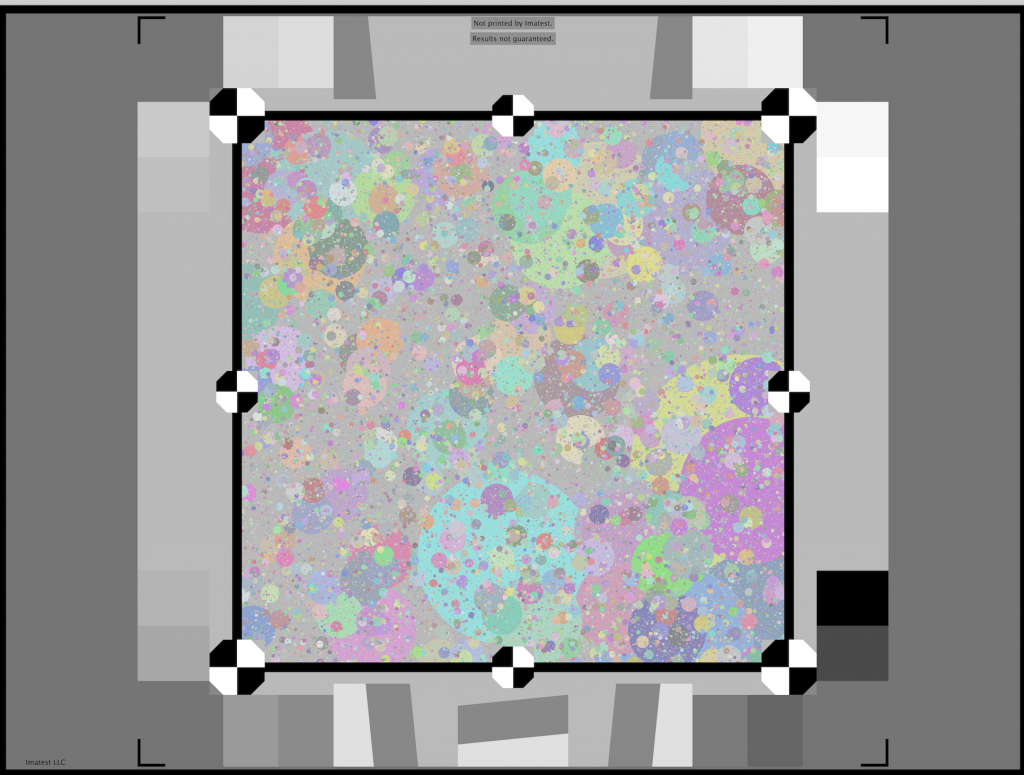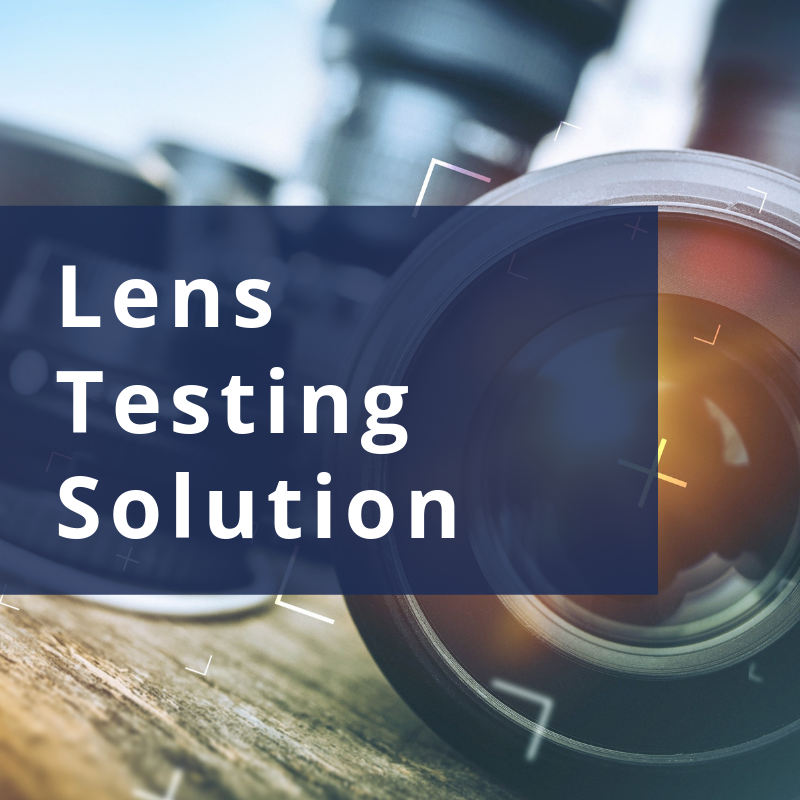Search Results for: MTF
Testing a macro lens using Checkerboard and Micro Multi-slide
Imatest’s Checkerboard module is our new flagship module for automated analysis of sharpness, distortion and chromatic aberration from a checkerboard (AKA chessboard) pattern. The big benefit of using the checkerboard is that there are looser framing requirements than with other kinds of test targets. While checkerboard lacks the color and tone analysis provided by SFRplus and eSFR ISO, these features are not available on the high precision chrome on glass substrate, so the checkerboard is the optimal pattern for this test.
Using Sharpness to Measure Your Autofocus Consistency
Autofocus plays a major role in many camera system applications with variable focus, including consumer electronic devices. Camera systems must be able to focus at a variety of distances. Optical systems on cameras only allow a certain range of distances from the camera to be in focus at once (this is often known as the depth of field, or depth of focus).
Spilled Coins Cross Test Chart
The updated Imatest Spilled Coins Cross test charts use cross-correlation calculation texture metrics to provide improved stability for images with nonlinear noise reduction. Users can now more accurately differentiate between noise and texture. Random/Dead Leaves Cross, which runs under the interactive Rescharts interface, measures SFR (Spatial Frequency Response) or MTF (Modulation Transfer Function) from random scale-invariant (or approximately scale-invariant) test charts, including “Dead Leaves” and “Spilled Coins” charts.
Long Range Testing
For lenses that focus out at long distances, to verify ability to focus on distant objects you will need a target system that produces an image that is at or beyond the hyperfocal distance of your lens. You can use our chartfinder utility to determine the size of your imaging plane at a distance based on your lens’ angular field of view. Jump to: Collimator Fixture | IMTS Target Projection | IBTS Stray Light/Target Projector Version | Projection Collimators | Multi-collimator systems | Physical Targets Virtual Target Projection Systems A collimator lens (also known as a close-up lens or relay lens) can change […]
Image Quality Factors
Image Quality Factors are also called Key Performance Indicators (KPIs). Sharpness Noise Dynamic-Range Color Accuracy Distortion Uniformity Chromatic Aberration Flare Color Moiré Artifacts Compression Links Image Quality Factor Video Series Summary table— Image quality factors and corresponding test charts and modules Sharpness Noise Dynamic range, tone, & contrast Color accuracy Lens Distortion Uniformity Blemishes ISO Sensitivity Lateral Chromatic Aberration Lens Flare (Veiling Glare) Color Moiré Artifacts Data compression losses Dmax Color gamut Texture Detail Overview of image quality and Imatest measurements Image quality is one […]
Artifacts
Noise reduction and sharpening Original | NR+Sharpening Software (especially operations performed during RAW conversion) can cause significant visual artifacts, including oversharpening “halos” and loss of fine, low-contrast detail. These artifacts result from nonlinear (nonuniform) signal processing (so-called because it varies with the signal). Images may be sharpened (MTF boosted) in the proximity of contrasty features like edges and blurred (lowpass filtered) in their absence. This generally improves measured performance (both sharpness from slanted-edges and noise/Signal-to-Noise Ratio (SNR) from chart patches), but it may result in a degradation of perceived image quality, for example, a “plasticy” cartoon-like appearance of skin even […]
Ultra-wide Camera Testing
Resolution Testing Fisheye (highly barrel-distorted) lenses can be effectively tested with several Imatest modules. SFRplus with pre-distorted test charts. If chart parameters are entered, distortion and Field of View (FoV) are calculated. eSFR ISO with pre-distorted test charts. Distortion and FoV are not currently calculated. Beyond around 160° it becomes increasingly difficult to fill the image plane with a planar test chart. We introduced SFRreg as a flexible target and analysis system for testing the resolution of ultra-wide cameras. (It can also be used for long-distance and depth of field testing) Example of an ultra-wide camera test setup: See […]
Lens Testing
The quality of a camera lens determines how an image forms on a sensor. Lens quality is tested to verify the lens is designed, built, and focused correctly. Once a highly tedious process, Imatest has since refined the testing practice with several solutions, including highly accurate and specific test charts and fixtures. Testing Distance – Sharpness – Chromatic Aberration – Lens Flare Geometric Calibration – Relevant Standards – Supply Chain Image Quality Testing Distance To determine what size of test chart is needed, use the Imatest Chart Finder that can also calculate the imaging plane based on the sensor […]
ISO 15739 — Noise measurements
Standard: ISO 15739:2017 — Photography — Electronic still-picture imaging— Noise measurements Technical Committee: ISO/TC 42 Photography Published: 2017-05 The Simplified ISO-15739 digital camera noise test chart is available from the Imatest Store. This chart can be analyzed by the Imatest Stepchart, Multicharts, and Multitest modules. Imatest 4.0+ includes a calculation of ISO 15739 visual noise as specified in Appendix B of the ISO 15739:2017 standard. And Imatest 4.4+ includes a calculation of visual noise from the IEEE CPIQ P1858 (Camera Phone Image Quality) 2016 specification, which is based on ISO 15739 with some added details. These are relatively complex […]
ISO 16505 — Road Vehicles — Camera Monitor Systems
Standard: ISO 16505:2015 Road vehicles — Ergonomic and performance aspects of Camera Monitor Systems — Requirements and test procedures. Technical Committee: ISO/TC 22/SC 35 Lighting and visibility Published: 2015-05-01 Test Targets ISO 16505 Test Targets are available for purchase on the Imatest Store. Test Methods Resolution References ISO 12233:2014. Hyperbolic wedge features can be analyzed by the Wedge or eSFR ISO module. Slanted edge features can be analyzed by the SFR, SFRplus, eSFR ISO, SFRreg, or Chekerboard modules. We presented a paper, “Measuring MTF with wedges: pitfalls and best practices” at the Multi-camera and Embedded Systems for Autonomous Machines […]
ISO 12233 — Resolution and spatial frequency responses
eSFR ISO: Analyze the ISO 12233:2017 Edge SFR chart* and ISO 12233:2023 Edge SFR chart Standard: ISO 12233:2017 — Photography— Electronic still picture imaging — Resolution and spatial frequency responses* ISO 12233:2023 — Photography— Electronic still picture imaging — Resolution and spatial frequency responses Technical Committee: ISO/TC 42 Photography Published: 2017-01, 2023-02 This new standard defines three test charts. The new Imatest eSFR ISO module performs a highly automated analysis of the new low contrast (4:1) Edge SFR chart and is available in Imatest Master and Image Sensor 4.0. * Note: ISO 12233:2014 has the same chart requirement.
Dynamic Range
Dynamic Range (DR) is the range of exposure, i.e., scene brightness, over which a camera responds with good contrast and good Signal-to-Noise Ratio (SNR). Related pages Veiling glare (lens flare) describes several measurement techniques, including the new Contrast Resolution method. Contrast Resolution – A special transmissive chart for measuring the visibility of low contrast features in larger fields over a wide dynamic range Making Dynamic Range Measurements Robust Against Flare Light Sensor vs. System DR – Flare, Charts, Exposure – DR definitions – Transmission chart – Lightbox How to measure DR – Overexposure – Minimizing reflections – Contrast Resolution chart Tips and recommendations […]
Imatest IT Test Items & Modules
The Test Items below are oriented towards manufacturing and quality control. The Imatest Module list shows each relevant output. “X” indicates optimal support for the test item and “/” indicates sub-optimal support. Sharpness Modules Test Item SFRplus eSFR ISO SFR SFRreg Random Log-f Contrast Wedge Star Sharpness (MTF) X X X X X X X X Limiting Resolution X X Lateral Chromatic Aberration X X X X Distortion X / Field of View X X Tilt X […]









